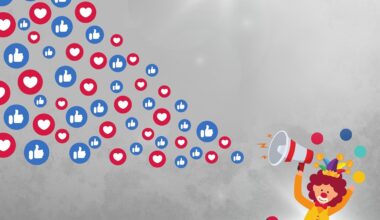Social Followers Growth: Integrating Paid and Organic Data in Google Analytics
In the evolving landscape of digital marketing, understanding the balance between paid and organic growth is crucial for brands aiming to expand their social media followers. Google Analytics serves as a powerful tool to analyze these growth strategies effectively, helping marketers gauge the performance of both paid ads and organic reach. By combining data from both channels, businesses can make informed decisions that maximize their engagement rates. It’s important to understand that these two growth strategies, while distinct, often influence one another. For example, well-targeted paid campaigns can increase organic growth by building brand awareness. Marketers can track various metrics in Google Analytics, such as user demographic data, traffic sources, and social engagement levels. By monitoring these metrics, brands can identify which strategies yield the best results for follower growth. Highlighting a holistic approach simplifies interpreting performance data, enabling better marketing decisions. Establishing this integration can lead to more efficient campaigns that complement each other and amplify results. In this article, we will explore strategies for leveraging both paid and organic data through Google Analytics.
Integrating paid and organic data within Google Analytics allows brands to gain valuable insights into user behavior and engagement. This integration starts by ensuring that both paid advertising campaigns and organic social media strategies are effectively tracked. For paid advertising, marketers often use UTM parameters to tag URLs, making it easier for Google Analytics to monitor the campaign’s performance. Marketers can focus on key metrics such as cost per acquisition (CPA), click-through rates (CTR), and conversion rates to evaluate paid campaigns. On the other hand, analyzing organic traffic helps in understanding how users find and interact with content without direct paid promotion. Important metrics for organic performance include user sessions, bounce rates, and engagement time. When reviewing these figures together, it becomes apparent how user interaction varies across both channels. By cross-referencing the data and identifying correlations, marketers can uncover the effectiveness of each approach. This multidisciplinary view enables companies to refine their strategies, optimize resource allocation, and ultimately enhance social follower growth. Understanding these dynamics paves the way for more efficient and targeted campaigns for increasing followers on various platforms.
Utilizing Google Analytics Features
Google Analytics offers various features that enable businesses to deeply analyze their growth efforts. One essential feature is the ability to create custom dashboards tailored to specific marketing goals. These dashboards can include metrics for both paid and organic growth, offering a comprehensive view of social engagement. Marketers can set up segments to differentiate traffic from paid campaigns versus organic sources. This distinction becomes invaluable for analyzing user behavior for targeted strategies. Additionally, utilizing Google Analytics goals helps businesses track specific conversions related to social followers. By calculating the conversion rate from paid ads, one can assess how effectively these campaigns translate into new followers. Another critical tool is the funnel visualization, allowing analysts to observe users’ pathways from their initial touchpoint to following the brand’s social media pages. Periodically reviewing this data helps identify bottlenecks in the conversion process and allows for adjustments in strategies. By leveraging insights from these tools, brands can ensure that their paid and organic efforts are both aligned and effective, enhancing social followers and overall engagement.
When analyzing the cohesive impact of paid and organic growth, businesses should also consider their content strategy across both channels. Content serves as the cornerstone of user engagement on social media platforms. Paid ads often promote specific pieces of content to drive traffic and follower acquisition. Therefore, aligning organic content strategies with these promotions can yield synergistic benefits. For instance, utilizing similar messaging and visuals across both paid and organic posts reinforces brand identity and message coherence. Posting organic content that corresponds with paid campaigns increases visibility and engagement through enhanced relevance. Coupling promotional strategies with engaging organic posts can lead to significant growth in followers. Moreover, it’s crucial to optimize the posting frequency and timing for both strategies based on audience behavior insights. Google Analytics can provide valuable data that informs when target audiences are most active online. Combining this knowledge with tailored content increases the chances of followers engaging with posts, resulting in higher follower counts. Adopting a synchronized content approach ensures that brands maintain a consistent and appealing presence across all marketing channels.
Evaluating Performance Metrics
Once brands have established their approach to integrating paid and organic growth data, evaluating performance metrics becomes paramount. Performance metrics not only indicate how well a strategy performs but also highlight areas for improvement. Using Google Analytics, brands can measure the return on investment (ROI) from paid advertising campaigns compared to organic efforts. This analysis helps marketers determine if their investments in paid growth strategies generate substantial follower returns. Metrics such as engagement rate, follower count, and the growth pace are essential indicators of success. Brands should also assess the cost correlation between paid advertising spends and the number of new organic followers gained during promotional efforts. Tools like custom reports enable businesses to myth-bust assumptions and create data-driven marketing strategies. Regularly reviewing these reports reinforces the importance of responsiveness to market changes and user preferences. Collaborating with social media managers and content creators ensures that insights from analytics translate to improved creative execution. This comprehensive data evaluation fosters a culture of continuous improvement that ultimately drives social followers organically and through paid channels.
Another crucial aspect that marketers should embrace is A/B testing for campaigns. A/B testing allows brands to compare two different strategies against each other to determine which performs better at attracting followers. This type of analysis can be applied to both paid ads and organic content. For paid campaigns, altering visuals, headlines, and CTA buttons can significantly impact engagement. Marketers can assess which variations yield higher click-through rates and evoke better emotional responses from audiences. Meanwhile, organic posts can also benefit from A/B testing; experimenting with different post lengths, formats, and times can unveil preferences among followers. Google Analytics tracks these variations over time to deliver insights about what engages users most effectively for both strategies. Marketers can then take this data to refine future strategies by allocating resources to the most successful methods. Continuously optimizing campaigns based on analytical insights ensures improving follower acquisition strategies over time. Firms embracing A/B testing create an adaptive marketing strategy that can evolve with audience trends and preferences. Thus, boosting social followers remains a sustainable target in a dynamic digital environment.
Conclusion: Merging Insights for Growth
In summary, integrating paid and organic strategies within Google Analytics is vital for effective social follower growth. By leveraging powerful tools that provide insights into user behavior, brands can develop a holistic marketing strategy. Understanding how both channels interact allows businesses to align their objectives, priority areas, and content approaches cohesively. As we’ve explored, key features within Google Analytics help identify performance trends and necessary adjustments in real-time. Furthermore, A/B testing emerges as an essential practice for optimizing campaigns. Consistent evaluation of performance metrics translates into informed decisions regarding future marketing pursuits. A robust integration strategy will lead to higher engagement rates on social platforms and sustainable growth over time. Marketers must keep adapting their strategies by marrying insights gathered from both paid and organic data analysis. This ensures they remain competitive in an increasingly crowded marketplace. As brands prioritize this integration, they can expect improved social follower metrics, enhancing their overall digital presence. Ultimately, monitoring and optimizing these efforts can empower marketers to drive meaningful interactions with their audience and foster loyalty.
The integration of paid and organic data within Google Analytics does not only enhance follower growth but also reinforces a strong brand presence in the digital landscape. With accurate tracking, consistent evaluation, and strategic insights, brands can navigate the complexities of social media marketing effectively. As they continue to innovate their approaches and experiment with different strategies, leveraging analytics will be the cornerstone of refining these efforts. The goal remains not just to increase numbers, but to build authentic connections with followers who resonate with the brand’s messages. A robust analytical foundation can inform future content development and prompt necessary pivots in marketing tactics. By fostering a culture of inquiry and responsiveness to audience needs, businesses can benefit immensely from a well-rounded approach to social media presence. Therefore, prioritizing the synthesis of insights from both paid and organic channels is the key to unlocking sustainable growth. Over time, aligning these strategies will substantiate a brand’s position as a leader in its industry. Ultimately, enabling cohesive follower growth requires dedication, strategic foresight, and a keen eye on analytics.


